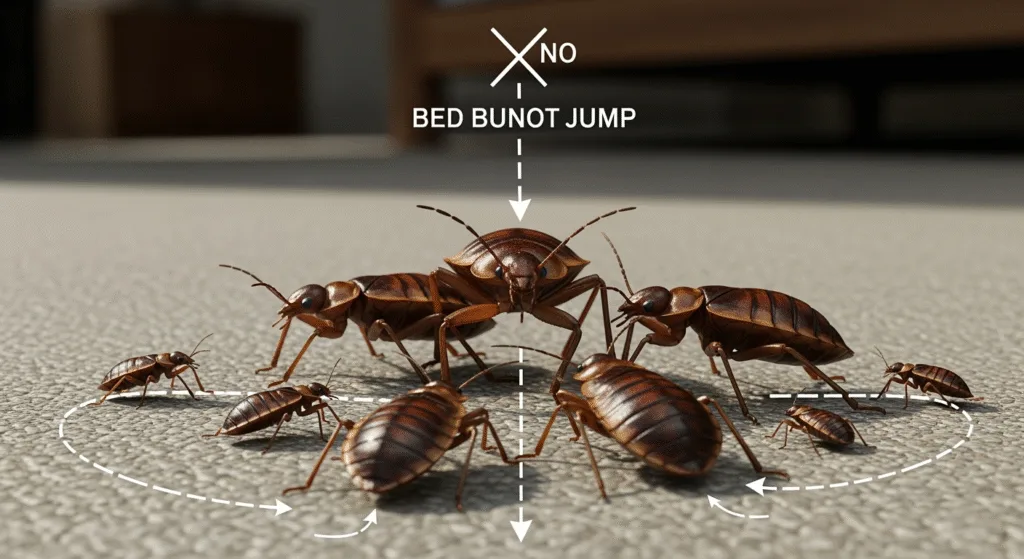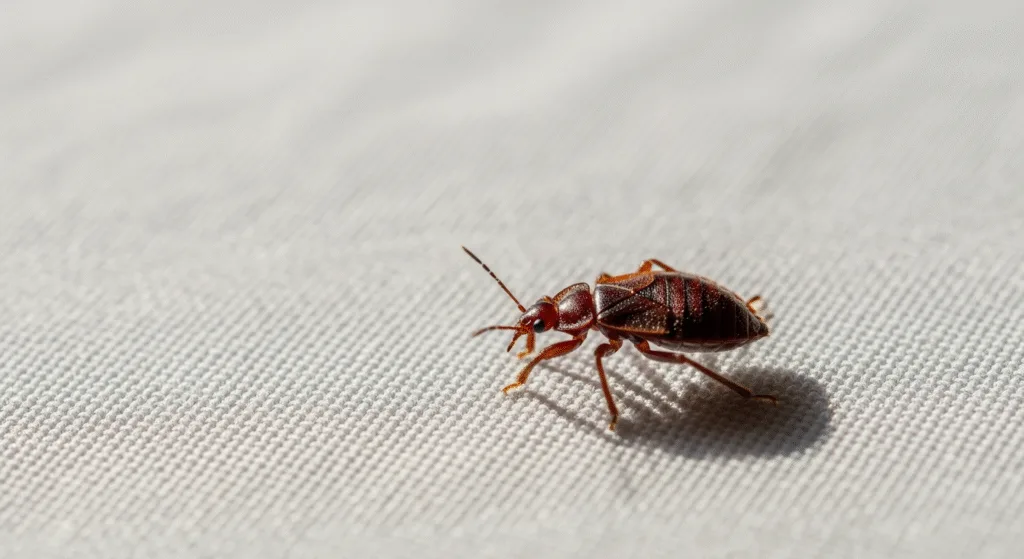Understanding the Mystery of Bed Bug Movement
Bed bugs spark both curiosity and concern. Many wonder: can bed bugs jump? Understanding how they move explains how infestations spread in homes, hotels, and offices. Unlike fleas or grasshoppers, bed bugs use very different methods of travel. In this article, we’ll explore how they move, whether they can jump or fly, and what you can do to protect yourself—using plain, research-backed explanations.
How Do Bed Bugs Move?

Contrary to popular belief, bed bugs do not jump. If you have asked yourself, can bed bugs jump, the answer is simple: no, they cannot. Instead, they crawl. Bed bugs have six tiny legs designed for crawling over surfaces like mattresses, walls, furniture, and clothing. Their legs end in claw-like structures that grip fabric and rough materials with ease. However, their body design does not allow for jumping like fleas or for flying like mosquitoes. The crawling movement of a bed bug is deliberate and steady. While they cannot cover large distances quickly on their own, bed bugs are expert hitchhikers. They latch onto your luggage, clothing, or belongings to travel discreetly into new environments. This talent makes them an enduring problem worldwide because human activity contributes directly to their spread.
Speed of Bed Bug Crawling
Bed bugs move slower compared to many insects. Studies show that an adult bed bug crawls about four feet per minute under ideal conditions. That may seem fast in close quarters like your bed or couch, but it is significantly slower than mosquitoes, ants, or cockroaches. The slower crawling speed has important implications. It means that when monitoring for bed bugs, experts can predict likely travel paths from bedding to furniture or from one side of the mattress to another.
Surface Matters
The type of surface bed bugs crawl on changes their mobility. Fabric and wood allow for better grip compared to smooth plastics or metals. For example, bed bugs may struggle to move quickly across a plastic bin or glass table, but they thrive when crawling over sheets, clothing, or upholstered surfaces. This explains why one of the best prevention steps is placing traps or interceptors under the legs of beds and couches. Smooth surfaces in the cups prevent bed bugs from crawling out.
Why Crawling Works for Bed Bugs
Although bed bugs cannot jump, their reliance on crawling is highly effective. Crawling conserves energy and allows them to stay undetected. Their bodies flatten easily, which helps them squeeze through tiny cracks and hiding places. Bed bugs use crawling to reach people while they sleep at night, waiting for the warmth and carbon dioxide humans release to guide them to a blood meal.
Debunking Common Myths About Bed Bug Movement
Bed bugs inspire myths, many of which confuse homeowners into mismanaging infestations. Let’s examine the most common misunderstandings about their mobility, especially the repeated question: can bed bugs jump?
Myth: Bed Bugs Fly
Bed bugs cannot fly. They lack wings. Their ancestors millions of years ago had wings, but bed bugs evolved as parasites specializing in staying close to human hosts. Once they shifted behavior to feed on humans while sleeping, wings lost their advantage. Therefore, modern bed bugs are flightless and rely only on crawling.
Myth: Bed Bugs Jump Like Fleas
One common myth is that bed bugs jump like fleas. Fleas have powerful legs designed specifically for jumping onto animals and moving quickly between hosts. Bed bugs, however, lack this advantage. Their bodies are not suited for propelling themselves through the air. Instead, they need to crawl onto a host or use human belongings as vehicles for transport.
Myth: Bed Bugs Move Fast Enough to Evade Detection
Because they crawl steadily rather than quickly, bed bugs cannot easily escape when you discover them. Their strategy depends on hiding during the day in tight cracks, seams, or behind headboards rather than outrunning threats. When exposed, a bed bug will crawl away instead of leaping or flying off. This limited escape strategy supports the idea that prevention and early detection can keep infestations more manageable.
The Science of Bed Bug Anatomy and Mobility
Understanding why can bed bugs jump has such a clear answer requires examining their biology. Bed bugs are insects in the family Cimicidae. They share characteristics with other crawling insects but have evolved traits specifically tailored for a life close to human hosts.
The Structure of Bed Bug Legs
Each bed bug has six legs with claws at the tips. These claws allow them to grip fabric and rough surfaces securely. However, their muscles and joint design lack the spring-loaded mechanism that fleas use for jumping. Their muscles excel in steady traction and climbing, not propulsion.
The Flat Body Advantage
Bed bugs have oval, flat bodies. This shape makes them excellent at squeezing into cracks as small as a credit card’s width. The flatness helps them move undetected and hide in mattresses, walls, and baseboards. Although this body design helps with hiding and crawling, it also limits their potential for explosive movements like jumping.
Sensory Contributions to Movement
The bed bugs’ primary sense guiding their movement is detection of heat and carbon dioxide. When close to a host, they crawl directly toward these cues. Because they lack the ability to jump, they must rely entirely on their senses to guide crawling movement. Unlike fleas, which jump repeatedly from host to host, bed bugs approach their feeding opportunities slowly but deliberately.
Comparison With Other Pests
| Insect | Can Jump? | Can Fly? | Primary Mode of Movement |
|---|---|---|---|
| Bed Bug | No | No | Crawling |
| Flea | Yes | No | Jumping |
| Mosquito | No | Yes | Flying |
| Ant | No | No | Crawling |
This table clearly illustrates how bed bugs differ from other common pests. Fleas leap impressively to access new hosts, while mosquitoes exploit wings to fly. Bed bugs remain grounded, moving only by crawling or hitchhiking.
How Do Bed Bugs Spread Without Jumping?

At this point you may ask: if bed bugs can’t jump or fly, how do they spread so effectively worldwide? The answer is connected closely to human activity. Bed bugs use every opportunity to hitch a ride and reach new places.
Hitchhiking on Luggage and Clothing
Bed bugs hide inside seams or pockets of luggage, backpacks, or jackets. Because they are small and flat, they conceal themselves without detection. When you move between a hotel room, a taxi, or your home, you may unknowingly provide free transportation for them. This explains why travel remains one of the main drivers of global bed bug infestations today.
Infestation Across Shared Buildings
Shared living spaces like apartment complexes, dormitories, and shelters see fast-spreading infestations. Bed bugs crawl through wall voids, pipes, or shared laundry machines to reach new units. Although they cannot jump directly floor to floor, their steady crawl through small openings enables building-wide infestations. Because of this, one apartment unit battling bed bugs often means that neighboring units also require inspection and treatment.
Public Transportation and Furniture
Bed bugs sometimes sneak onto buses, movie theaters, or office chairs. Once one person unknowingly carries them on clothing, they crawl onto seats or nearby surfaces, ready to move again. Similarly, used furniture serves as one of the biggest culprits in bed bug spread. Picking up discarded couches or mattresses often introduces infestations into new homes.
Prevention and Control Strategies
Now that we know the answer to the question can bed bugs jump is no, preventing infestations depends more on careful inspection and smart travel habits rather than blocking jumps or flights.
Inspection Tips
- Check mattress seams, headboards, and box springs for dark spots and small insects.
- Examine luggage carefully after traveling.
- Look for molted skins, fecal stains, and small white eggs in hidden cracks.
Protective Measures
- Use encasements on mattresses and box springs to reduce hiding spots.
- Avoid picking up secondhand furniture unless carefully inspected or treated by professionals.
- Launder and dry clothing on high heat after travel to kill bed bugs hiding in fabrics.
Treatment Options
Professional pest control remains the most reliable treatment approach, as bed bugs resist many do-it-yourself sprays. Methods include:
- Chemical insecticides applied with expertise to target hidden harborages.
- Heat treatments raising room temperature above 120°F, lethal to all life stages.
- Steam treatments that penetrate furniture cracks.
Homeowners should avoid quick-fix solutions or overuse of harmful chemicals, which often worsens the problem and creates unnecessary hazards.
Real-World Insights: Why People Still Ask “Can Bed Bugs Jump?”
Despite years of research, the question can bed bugs jump still finds its way into pest discussions. There are several reasons for this persistent confusion.
Misidentification of Insects
People often mix up pests. Fleas, spider beetles, or even carpet beetles sometimes invade homes and are mistaken for bed bugs. If someone sees small insects jumping, they may assume they are bed bugs rather than fleas. This misidentification spreads the original myth.
Observing Rapid Crawling
Because bed bugs crawl quickly in small spaces, their movement may appear like short hops, especially at night. In reality, the movement is straightforward crawling, but human eyes misinterpret in low-light conditions.
Exaggeration in Popular Culture
Movies, stories, and online discussions often overdramatize bed bugs. These dramatic accounts present them as jumping or flying when the truth is much simpler. Sadly, myths sometimes carry more appeal than facts.
Conclusion: The Truth About Bed Bug Movement
So, can bed bugs jump? By now you know that bed bugs do not jump or fly. Their crawling ability and hitchhiking behavior explain how they spread so effectively despite these physical limitations. The misunderstanding comes from confusing them with similar insects like fleas. While bed bugs cannot leap, they excel at clinging, hiding, and waiting until their human hosts unknowingly move them to new areas. For prevention, homeowners must focus on careful inspection, safe travel practices, and immediate professional help if signs of infestation appear. The more the public understands about true bed bug behavior, the better chances society has at reducing infestations. Remember, prevention always costs less and saves more pain than treatment after an infestation takes root.



